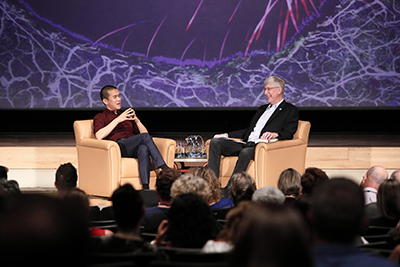Let’s Talk Microbes
The Big Read at NIH Featured Author Ed Yong
Let’s talk microbes! This is what members of the NIH community were doing this spring as they came together to discuss science journalist Ed Yong’s 2016 book I Contain Multitudes: The Microbes Within Us and a Grander View of Life as a part of the second annual Big Read at the NIH. Then, on June 5, the award-winning author visited NIH for an informal conversation about the book in Masur Auditorium (Building 10) with NIH Director Francis Collins.

PHOTO BY CHIA-CHI CHARLIE CHANG
The second annual Big Read at NIH featured Ed Yong and his book I Contain Multitudes: The Microbes Within Us and a Grander View of Life. Yong visited NIH for an informal conversation about the book with NIH Director Francis Collins.
The Big Read, a nationwide event initiated by the National Endowment for the Arts, aims to foster collaboration and community across the NIH through the discussion about a single book over several months. This is our second year participating in a local Big Read event. To promote book conversations, the NIH Library made an eBook version of I Contain Multitudes available through its collection, held three discussion groups, and offered training sessions to guide individuals in organizing their own book groups. These Big Read activities brought together a wide range of people from across the NIH.
Scientists have been studying the microbiome for centuries, but research in this area has picked up dramatically in the last few decades. The idea that bacteria cause disease, the well-known germ theory, has misled many people to believe microbes need to be eradicated to cure disease. However, it is now understood that most microbes do not make us sick. In his book, Yong explains the complex relationships between bacteria and animals, the benefits of these partnerships, and what happens when these partnerships go awry.
Yong spent six months researching and reporting for his book and interviewed more than 100 people in the process. During his conversation with Collins, he explained that in deciding what to include in the book, he “gravitated toward things that would provide really good stories [and] would illuminate some of the broader themes about how the microbiome works.” In structuring the book around the particular relationships between microbes and their hosts, Yong wanted to create something that “would stand the test of time even as new papers and discoveries were continuing to be published.” He hopes that people who read his book will understand that “microbes are not just things to go ‘eww’ over or to fear [but] are a dominant life from of the planet.”

PHOTO BY CHIA-CHI CHARLIE CHANG
In his book, Ed Yong explains the complex relationships between bacteria and animals, the benefits of these partnerships, and what happens when these partnerships go awry.
Although this is his first book, Yong is a prolific science writer and currently reports for The Atlantic; his work has been featured in National Geographic, the New Yorker, Scientific American, and other publications. It was with “an urge to explain, to describe, to tell stories” that he first began science writing in 2006. He described the experience of writing his first book as a joy. It has become a New York Times (NYT) best seller and earned him a spot in the best-of-2016 lists by the NYT, National Public Radio, the Economist, the Guardian, and several others.
“Do you have any advice for scientists about their own responsibilities and opportunities to communicate what they do?” Collins asked near the end of the program.
“I think good science writing and good science communication is not just about…explaining it in lay language,” Yong said. “It is also about explaining how that science came to be, like the stories behind it and the stories of the people behind it. That’s what I tried to get across in the book [and] in all the pieces I write.”
The Big Read was sponsored by the Foundation for Advanced Education in the Sciences. To watch a videocast of Yong’s June 5, 2018, presentation, go to https://videocast.nih.gov/launch.asp?23932.
This page was last updated on Thursday, April 7, 2022
